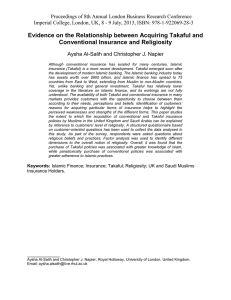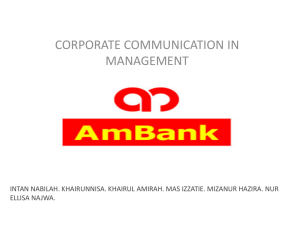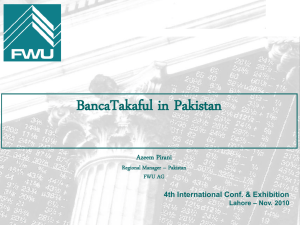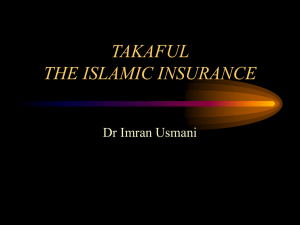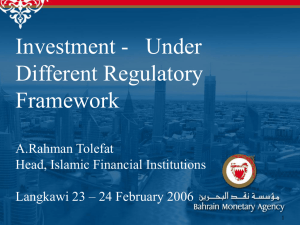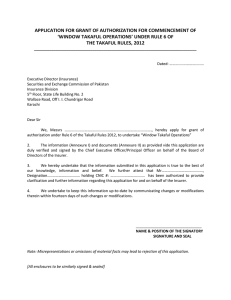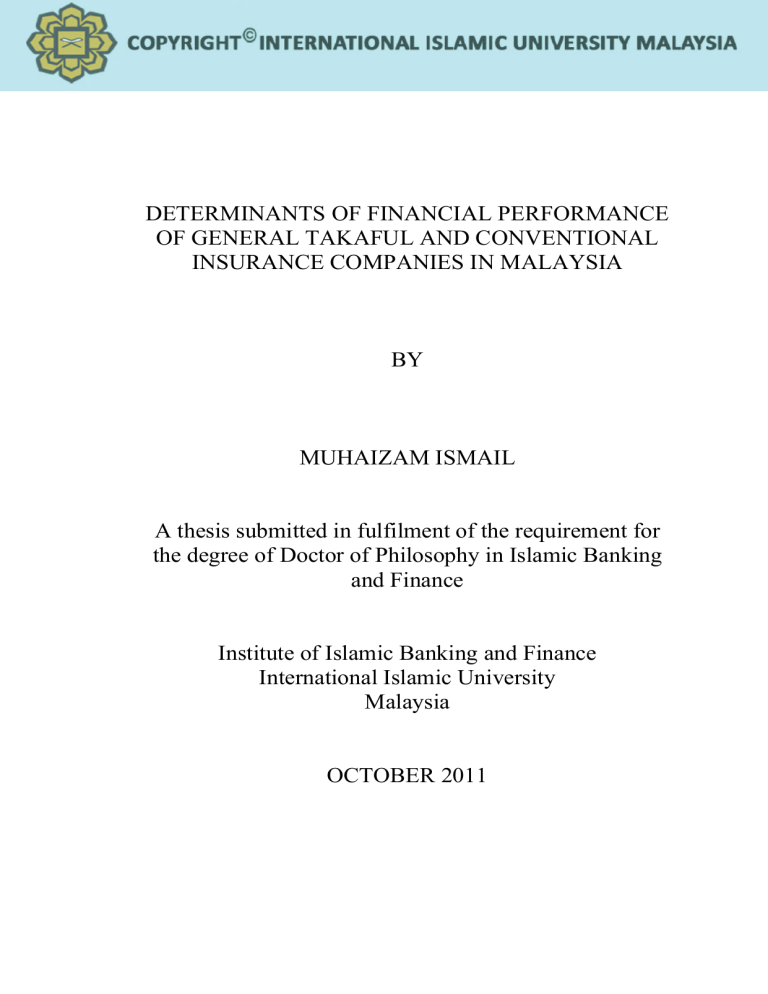
DETERMINANTS OF FINANCIAL PERFORMANCE
OF GENERAL TAKAFUL AND CONVENTIONAL
INSURANCE COMPANIES IN MALAYSIA
BY
MUHAIZAM ISMAIL
A thesis submitted in fulfilment of the requirement for
the degree of Doctor of Philosophy in Islamic Banking
and Finance
Institute of Islamic Banking and Finance
International Islamic University
Malaysia
OCTOBER 2011
ABSTRACT
Preserving financial stability is integral in developing financial institutions that are
robust, resilient, effective and competitive. As such, this study examined factors that
would affect the financial performance of the general takaful and conventional
insurance companies in Malaysia. The main contribution of this study is that it is the
first attempt to empirically investigate the determinants of the financial performance
of general takaful and conventional insurance companies in Malaysia using a panel
data set consisting of firm-specific data and economic data. In addition, this study
pooled the data of the general takaful and conventional insurance companies to
determine the overall perspective of the determinants of financial performance of the
insurance industry in Malaysia. Two financial performance measures, which are
investment yield and combined ratio, are used to capture the different aspects of the
general takaful and conventional insurance operations in Malaysia. In analysing the
determinants of the financial performance of the general takaful companies, the study
examined the profit rate levels, equity returns of Shariah-compliant investments, size
of company, retakaful dependence, solvency margin, liquidity, and contribution
growth. In the case of conventional insurance, the factors examined in this study are
interest rate levels, equity returns, size of company, reinsurance dependence, solvency
margin, liquidity, and premium growth. The data covered a four-year period from
January 2004 to October 2007. Three models of panel data estimation were employed,
which are generalized least squares with non effects, generalized least squares with
fixed effects and generalized least squares with random effects. These models were
estimated for both performance measures. Based on the empirical results, this study
found that size of company, retakaful dependence and solvency margin are
statistically significant determinants of the investment performance of takaful
companies. For conventional insurance, all factors are statistically significant
determinants of investment performance, except for equity returns. In terms of
underwriting performance, which is represented by the combined ratio, this study
found that profit rate levels, equity returns, size of company, solvency margin and
liquidity are significant determinants for the takaful sector. The findings for
conventional insurance indicate that all factors are statistically significant
determinants of the underwriting performance, with the exception of liquidity. The
findings for the pooled data of the general takaful and conventional insurance
companies are mostly consistent with the findings of the takaful and conventional
insurance sectors.
ii APPROVAL PAGE
The thesis of Muhaizam Binti Ismail has been approved by the following:
___________________________________
Norma Md. Saad
Supervisor
___________________________________
Zarinah Hamid
Co-Supervisor
___________________________________
Mohd Azmi Haji Omar
Internal Examiner
__________________________________
Zuriah Abdul Rahman
External Examiner
___________________________________
Nasr Eldin Ibrahim Ahmed
Chairman iv DECLARATION
I hereby declare that this dissertation is the result of my own investigations, except
where otherwise stated. I also declare that it has not been previously or concurrently
submitted as a whole for any other degrees at IIUM or other institutions.
Muhaizam Binti Ismail
Date………………… Signature……………………………….
v INTERNATIONAL ISLAMIC UNIVERSITY MALAYSIA
DECLARATION OF COPYRIGHT AND AFFIRMATION
OF FAIR USE OF UNPUBLISHED RESEARCH
Copyright © 2011 by Muhaizam Binti Ismail. All rights reserved.
DETERMINANTS OF FINANCIAL PERFORMANCE OF GENERAL
TAKAFUL AND CONVENTIONAL INSURANCE COMPANIES IN
MALAYSIA
No part of this unpublished research may be reproduced, stored in a retrieval system,
or transmitted, in any form or by any means, electronics, mechanical, photocopying,
recording or otherwise without prior written permission of the copyright holder except
as provided below.
1.
Any material contained in or derived from this unpublished research
may only be used by others in their writing with due acknowledgement.
2.
IIUM or its library will have the right to make and transmit copies
(print or electronic) for institutional and academic purposes.
3.
The IIUM library will have the right to make, store in a retrieval
system and supply copies of this unpublished research if requested by
other universities and research libraries.
Affirmed by Muhaizam Binti Ismail.
…………………………..
Signature
.....……………
Date
vi ACKNOWLEDGEMENTS
I would like to express my utmost gratitude and thanks to my main supervisor,
Associate Professor Dr. Norma Md. Saad and co-supervisor, Associate Professor Dr.
Zarinah Hamid for their guidance, valuable time, direction, insightful suggestions and
ideas throughout my Ph.D. programme. I also wish to extend my appreciation to the
Dean, Deputy Dean, management members and administrative staff of the IIUM
Institute of Islamic Banking and Finance (IIiBF) for their assistance during my
doctoral programme at IIiBF. My special thanks go to Associate Professor Dr. Younes
Soualhi for his comments during my proposal defence and to the external and internal
examiners for their suggestions to further improve the quality of this thesis. I am
grateful to Dr. Mohamed Abdul Hamid and Dr. Aisyah Abdul Rahman for the
valuable advice that they have extended to me during the process of completing this
thesis. For those mentioned above, may you be blessed and rewarded by Allah
Subhanahu wa-ta'ala. I would also like to express my appreciation to my husband,
Nasser Abu Bakar and children, Amirul Hakeem, Nur Hazeeqah, Muhammad Hafeez
and Nurin Haritha for their prayers, encouragement and unfailing support throughout
my study. Finally, I would like to acknowledge the Central Bank of Malaysia for
giving me the opportunity to undertake my doctorate research at the International
Islamic University Malaysia.
vii TABLE OF CONTENTS
Abstract ................................................................................................................... ii
Abstract in Arabic ....................................................................................................
Approval Page .......................................................................................................... iii
Declaration Page ...................................................................................................... iv
Copyright Page......................................................................................................... v
Acknowledgements .................................................................................................. vi
List of Tables .......................................................................................................... xii
List of Figures .......................................................................................................... xv
CHAPTER ONE: INTRODUCTION .................................................................. 1
1.1 Introduction ........................................................................................... 1
1.2 Background of Study ............................................................................ 2
1.3 Problem Statement ................................................................................ 10
1.4 Research Objectives .............................................................................. 14
1.5 Research Questions ............................................................................... 14
1.6 Contribution and Significance of Study ................................................ 16
1.7 Scope of Study ...................................................................................... 20
1.8 Organisation of the Study ..................................................................... 21
CHAPTER TWO: THEORETICAL OVERVIEW AND DEVELOPMENT
OF TAKAFUL ....................................................................................................... 22
2.1 Introduction ........................................................................................... 22
2.2 Historical Development and Origin of Takaful .................................... 22
2.3 Concept and Definition of Takaful ....................................................... 23
2.4 Shariah Basis of Takaful ....................................................................... 25
2.5 Form of Entity in Takaful Arrangement ............................................... 26
2.5.1 Non-profit or Cooperative Entity ................................................ 26
2.5.2 Institutionalised Takaful Entity ................................................... 26
2.6 Form of Contract in the Takaful Arrangement ..................................... 27
2.7 Takaful Business Model........................................................................ 28
2.7.1 Pure Mudharabah (Profit Sharing) Model .................................. 28
2.7.2 Modified Mudharabah (Profit Sharing) Model ........................... 29
2.7.3 Pure Wakalah (Agency) Model ................................................... 29
2.7.4 Combination of Wakalah (Agency) and Mudharabah
(Profit Sharing) Model................................................................. 30
2.7.5 Wakalah (Agency) Waqf (Endowment) Model ........................... 31
2.8 Comparison between Takaful and Conventional Insurance.................. 32
2.9 Shariah Non-compliant Aspect of Conventional Insurance .................. 34
2.9.1 Gharar (Uncertainty) ................................................................... 34
2.9.2 Riba (Usury or Taking and Charging Interest) ............................ 35
2.9.3 Maysir (Gambling) ...................................................................... 35
2.10 Principles of General Takaful Contract .............................................. 36
viii 2.10.1 Permissible Takaful Interest....................................................... 36
2.10.2 Utmost Good Faith
.................................................... 37
2.10.3 Principle of Indemnity ............................................................... 37
2.10.4 Principle of Subrogation ............................................................ 37
2.11 Development of Global Takaful Business .......................................... 37
2.12 Conclusion .......................................................................................... 41
CHAPTER THREE: GENERAL TAKAFUL AND CONVENTIONAL
INSURANCE IN MALAYSIA.............................................................................. 42
3.1 Introduction ............................................................................................ 42
3.2 Takaful Industry in Malaysia ................................................................ 42
3.2.1 The Birth of Takaful in Malaysia ................................................ 42
3.2.2 Market Structure .......................................................................... 43
3.2.3 Business Model............................................................................ 46
3.2.4 Financial Performance of the General Takaful
Business ....................................................................................... 50
3.3 Conventional Insurance Industry in Malaysia ...................................... 51
3.3.1 Conventional Insurance Market................................................... 51
3.3.2 Business Model............................................................................ 52
3.3.3 Financial Performance of the General Conventional
Insurance Business ................................................................................ 54
3.4 Operation of General Takaful and Conventional
Insurance Businesses ................................................................................... 55
3.4.1 Product Development .................................................................. 56
3.4.2 Marketing..................................................................................... 57
3.4.3 Underwriting ................................................................................ 58
3.4.4 Collection of Contributions or Premiums .................................... 58
3.4.5 Retakaful or Reinsurance............................................................. 58
3.4.6 Investment ................................................................................... 60
3.4.7 Claims Management .................................................................... 61
3.5 General Takaful or Conventional Insurance Products .......................... 62
3.5.1 Product Features .......................................................................... 62
3.5.2 Composition of Business ............................................................. 65
3.6 General Takaful or Conventional Insurance Accounts ......................... 66
3.7 The Regulatory and Supervisory Body for Takaful and
Conventional Insurance Industries ............................................................... 66
3.8 The Regulatory and Supervisory Framework ....................................... 67
3.8.1 Risk-Based Supervisory Framework ........................................... 68
3.8.2 Risk-Based Capital Framework ................................................... 68
3.8.3 Risks in General Takaful and Conventional
Insurance Activities............................................................................... 69
3.9 The Actuary of Takaful and Conventional Insurance
Companies.................................................................................................... 72
3.10 Conclusion ....................................................................................... 74
ix CHAPTER FOUR: THEORETICAL FRAMEWORK AND LITERATURE
REVIEW ............................................................................................................ 75
4.1 Introduction ........................................................................................... 75
4.2 Theoretical Background ........................................................................ 75
4.2.1 Theory of Firms and Managerial Behavior ................................. 75
4.2.2 Agency Theory ............................................................................ 76
4.2.3 Factors Affecting the Performance of Conventional
Insurance Companies ............................................................................ 80
4.2.3.1 Economic or Market Factors ................................................ 80
4.2.3.2 Firm-specific Factors ............................................................ 83
4.3 Empirical Evidence on the Determinants of Financial
Performance of Conventional Insurance Companies ................................... 91
4.4 Are Determinants of Financial Performance of Takaful
Different from Conventional Insurance? .................................................... 101
4.5 Conclusion ............................................................................................ 102
CHAPTER FIVE: RESEARCH DESIGN AND METHODOLOGY ............... 116
5.1 Introduction ........................................................................................... 116
5.2 Data Description ................................................................................... 116
5.2.1 Firm-specific Data ....................................................................... 116
5.2.1.1 Takaful Financial Data ......................................................... 118
5.2.1.2 Insurance Financial Data ...................................................... 119
5.2.2 Economic Data ............................................................................. 120
5.2.2.1 Profit Rate and Interest Rate Levels ..................................... 120
5.2.2.2 Equity Returns ...................................................................... 121
5.3 Dependent Variables and Measurements .............................................. 122
5.3.1 Performance Measurements ........................................................ 123
5.3.2 Performance Measure for Takaful and Conventional
Insurance Companies ............................................................................ 123
5.3.3 Selection of Performance Measure .............................................. 126
5.4 Independent Variables and Hypotheses Development .......................... 128
5.4.1 Economic Variables ..................................................................... 128
5.4.1.1 Profit or Interest Rate Levels................................................ 128
5.4.1.2 Equity Returns ...................................................................... 129
5.4.2 Firm-specific Variables ............................................................... 130
5.4.2.1 Company Size....................................................................... 130
5.4.2.2 Retakaful or Reinsurance Dependence................................. 131
5.4.2.3 Solvency Margin .................................................................. 132
5.4.2.4 Stability of Underwriting Operation or Contribution or
Premium Growth .............................................................................. 133
5.4.2.5 Liquidity ............................................................................... 134
5.5 General Functions of the Models .......................................................... 137
5.6 Estimation Models ................................................................................ 139
5.6.1 Model for Takaful ........................................................................ 140
5.6.2 Model for Conventional Insurance .............................................. 140
5.6.3 Model for Insurance Industry ...................................................... 141
5.7 Estimation Method ................................................................................ 143
5.7.1 Pooled Time-series Cross-sectional Regression:
x Non Effects Model ................................................................................ 143
5.7.1.1 Model 1 for Takaful ............................................................. 145
5.7.1.2 Model 1 for Conventional Insurance .................................... 145
5.7.1.3 Model 1 for Insurance Industry ............................................ 145
5.7.2 Panel Data Regression Model: Fixed Effects and
Random Effects ..................................................................................... 146
5.7.2.1 Fixed Effects Model ............................................................. 147
5.7.2.1.1 Model 2 for Takaful ...................................................... 147
5.7.2.1.2 Model 2 for Conventional Insurance…... ..................... 147
5.7.2.1.3 Model 2 for Insurance Industry .................................... 148
5.7.2.2 Random Effects Model ......................................................... 152
5.7.2.2.1 Model 3 for Takaful ...................................................... 153
5.7.2.2.2 Model 3 for Conventional Insurance ............................ 153
5.7.2.2.3 Model 3 for Insurance Industry .................................... 153
5.7.3 Model Specification Test ............................................................. 156
5.7.3.1 Likelihood Ratio Test: Model Selection for Non
Effects Model or Fixed Effects Model ............................................. 156
5.7.3.2 Hausman Test: Model Selection for Fixed Effects Model
or Random Effects Model ................................................................ 157
5.8 Diagnostic Tests .................................................................................... 158
5.8.1 Normality Test ............................................................................. 158
5.8.2 Multicollinearity Test .................................................................. 159
5.8.3 Heteroscedasticity Test ................................................................ 160
5.8.4 Autocorrelation Test .................................................................... 160
5.9 Conclusion ............................................................................................ 161
CHAPTER SIX: EMPIRICAL RESULTS ......................................................... 166
6.1 Introduction ........................................................................................... 166
6.2 Descriptive Statistics ............................................................................. 166
6.2.1 Sample Mean and Standard Deviation of Takaful and Conventional
Insurance ............................................................................................... 167
6.2.2 Normality Test ............................................................................. 171
6.3 Diagnostic Tests .................................................................................... 175
6.3.1 Multicollinearity .......................................................................... 175
6.3.2 Heteroscedasticity ........................................................................ 178
6.3.3 Autocorrelation ............................................................................ 179
6.4 Determinants of Financial Performance ............................................... 180
6.4.1 Estimation Models ....................................................................... 180
6.4.2 Model Selection Tests ................................................................. 180
6.4.3 Regression Results based on the Best Estimation Model ............ 186
6.4.3.1 Determinants of Financial Performance for Takaful and
Conventional Insurance .................................................................... 186
6.4.3.1.1 Investment Yield as a Performance Measure ............... 186
6.4.3.1.2 Combined Ratio as a Performance Measure................. 196
6.4.3.2 Determinants of Financial Performance of the Insurance
Industry............................................................................................. 203
6.5 Conclusion ............................................................................................ 208
xi CHAPTER SEVEN: SUMMARY AND CONCLUSION .................................. 212
7.1 Summary of Thesis and Findings.......................................................... 212
7.2 The Contribution of the Research ......................................................... 228
7.3 Implications and Limitations of Study .................................................. 229
7.4 Avenues for Further Research............................................................... 233
BIBLIOGRAPHY .................................................................................................. 236
APPENDIX I
..................................................................................................... 246
APPENDIX II ..................................................................................................... 247
APPENDIX III ..................................................................................................... 248
APPENDIX IV (A) .................................................................................................. 249
APPENDIX IV (B) .................................................................................................. 250
APPENDIX IV (C) .................................................................................................. 251
APPENDIX V (A) ................................................................................................... 252
APPENDIX V (B).................................................................................................... 253
APPENDIX V (C).................................................................................................... 254
APPENDIX VI ..................................................................................................... 255
APPENDIX VII ..................................................................................................... 256
APPENDIX VIII ..................................................................................................... 257
APPENDIX IX ..................................................................................................... 258
APPENDIX X ..................................................................................................... 259
APPENDIX XI .....................................................................................................
APPENDIX XII .....................................................................................................
xii LIST OF TABLES
Table No.
1.1
Page No.
List of Research Questions – Takaful and Conventional
Insurance
15
1.2
List of Research Questions – Insurance Industry
16
2.1
Definitions of Takaful
24
2.2
Differences in the Features of Takaful and Conventional
Insurance
32
3.1
List of Takaful Companies in Malaysia
44
3.2
Features of the General Takaful Business Model
48
3.3
General Takaful Contribution Income
50
3.4
Underwriting Performance of the General Takaful Business
51
3.5
Features of General Conventional Insurance Business Model
53
3.6
Underwriting Performance of the General Conventional
Insurance Business
54
3.7
Distribution of General Takaful Gross Contribution Income
65
3.8
Distribution of General Conventional Insurance Gross
Premium Income
65
3.9
Common Classification of Risks for Insurance Activities
72
4.1
Agency Relationships of Takaful and Conventional
Insurance Companies in Malaysia
79
4.2
Focus of Previous Studies
104
4.3
Empirical Studies on the Determinants of Insurance
Companies Performance
105
Summary of Findings on Previous Studies on
Financial Performance of Conventional Insurance Business
112
4.4
xiii 5.1
Performance Indicators for General Insurance Business
124
5.2
Summary of Measurements for the Independent Variables
162
5.3
Variables, Hypotheses Statement and Expected Coefficient
163
6.1 (A) Descriptive Statistics - Takaful
173
6.1 (B) Descriptive Statistics - Conventional Insurance
174
6.2 (A) Correlation Matrix of Independent Variables - Takaful
176
6.2 (B) Correlation Matrix of Independent Variables - Conventional
Insurance
176
6.2 (C) Correlation Matrix of Independent Variables - lnsurance
Industry
176
6.3 (A) Variance Inflation Factor (VIF) for Independent Variables
- Takaful
177
6.3 (B) Variance Inflation Factor (VIF) for Independent Variables
- Conventional Insurance
177
6.3 (C) Variance Inflation Factor (VIF) for Independent Variables
- Insurance Industry
177
6.4
179
Breusch-Pagan / Cook-Weisberg Test of Heteroscedasticity
6.5(A) Panel Specification Test - Takaful
183
6.5(B) Panel Specification Test - Conventional Insurance
184
6.5(C) Panel Specification Test – Insurance Industry
185
6.6
Determinants of Takaful Financial Performance
205
6.7
Determinants of Conventional Insurance Financial
Performance
206
Determinants of Insurance Industry Financial
Performance
207
6.8
xiv LIST OF FIGURES
Figure No.
Page No.
2.1
Number of Islamic Insurance Companies in 2007
38
2.2
Global Takaful Gross Contribution Income by Region 2005
to 2007
39
3.1
General Takaful Business Model
47
3.2
General Conventional Insurance Business Model
53
3.3
General Conventional Insurance Business Operation
56
5.1
A Model of the Theoretical Framework of the Determinants
of Financial Performance of the General Takaful and Conventional
Insurance in Malaysia
xv 136
CHAPTER ONE
INTRODUCTION
1.1
INTRODUCTION
Investigation on the performance of insurance companies has been the focus of a large
body of past and current research such as the studies by Adams (1996), Chidambaran,
Pugel and Saunders (1997), Adams and Buckle (2003), Shiu (2004) and Hrechaniuk,
Lutz and Talavera (2007). In general, firm performance refers to a firm’s actual
outputs or results as measured against its intended outputs which are the goals and
objectives.1 In terms of financial performance, Venkaratnam and Vasudevan (1986)
define it as the narrowest concept of business performance which focuses on the use
of financial based indicators that reflect the fulfillment of the economic goals of the
organisation. The aim of this study is to gain insight into the determinants of financial
performance of the general Islamic and conventional insurance companies in
Malaysia. Studies on the financial performance of the Islamic and conventional
insurance companies are of interest to various stakeholders such as the shareholders,
regulators, participants and policyholders. This is because preserving financial
stability is one of the key requirements in developing Islamic and conventional
insurance companies that are robust, resilient, effective and competitive.
1.2
BACKGROUND OF STUDY
The study on firm performance draws on a number of disciplines such as economics,
business management, business policy, finance and accounting. According to Lentz
1
Wikipedia, “Organizational Performance,” <http://www.en.wikipedia.org> (accessed 30, January
2008).
1
(1981) there are six categories of research on firm’s performance. The first category is
the study of the relationship between environment and performance. The most
extensive studies in this area are found in the literature of economic industrial
organisation.2 In this discipline, environment is the market or industry in which a firm
competes.3
The measure for market structures typically reflects the overall
arrangement of a competitive setting. 4 Numerous studies have linked firm or total
industry performance with industry structure such as the number of buyers and sellers,
industry growth, costs structure, product differentiation, concentration ratio and entry
barriers (Bain, 1956, 1959; Scherer, 1970). Most industrial organisation researchers
have been interested in the relationship between industry structure and total industry
performance. Over the years, researchers have begun to examine the relationships
between performance and characteristics unique to a business or group of businesses
within an industry. This leads to the second category of research on firm performance,
which is the study of the relationships of environment, strategy and performance.
Studies by Hunt (1972) and Newman (1973) which focus on firm-related variables
prove that the characteristics or relative competitive position of firms within industries
affect performance. Schoeffler, Buzzell & Heany (1974) adopt the profit impact of
market strategies (PIMS) model to analyse business unit performance in different
industries for competitive position and industry structure. The features of competitive
position are the relative market share, product quality and investment intensity,
marketing expenditure, research and development expenditure and breadth of product
line. The study shows that the joint effects of market conditions and corporate strategy
2
Lentz, R.T., “Determinants’ of Organizational Performance: An Interdisciplinary Review”, Strategic
Management Journal, vol. 2, no. 2, (1981): 131 – 154.
3
Ibid.
4
Ibid.
2
explain up to eighty percent of the variation on return on investment.5 Research on
industrial organisation provides convincing evidence that industry structure and the
competitive position of the firm influence performance.
The third category is the study of the relationship between organisation
structure and performance. Hall (1977) suggests that organisation structure has two
basic functions, each of which is likely to affect individual behaviour and
organisational performance. The first function is to minimise or at least regulate the
influence of individual variations on the organisation.6 Second, it provides the setting
in which power is exercised, decisions are made and the organisation’s activities are
carried out.7 According to Campbell, Bownas, Peterson and Dunnette (1974), the
structural qualities of an organisation are its physical characteristics, such as absolute
size, span of control, flat/tall hierarchy and administrative intensity. The type of
organisation structure which is often studied is the absolute size and multi-divisional
structure (M-form).8 Hall and Weiss (1967) discover a positive relationship between
size and profitability from a sample of over 300 Fortune companies. In terms of Mform structure, Armour and Teece (1978) observe a positive relationship between Mform structure and return on equity of 28 petroleum companies, studied during the
period of 1955 to 1973.
The fourth is the study which relates organisation performance with the degree
of congruence between environment and organisation structure (Burns and Stalker,
1961). According to White and Hamermesh (1981), the predominant line of thought in
organisational theory has come to be known as contingency theory whereby
5
Ibid.
Ibid.
7
Ibid.
8
Campbell, J. P., Bownas, D. A., Peterson, N. G. & Dunnette, M. D., “The Measurement of
Organizational Effectiveness: A Review of the Relevant Research and Opinion”, Report Tr-71-I (Final
Technical Report), San Diego: Navy Personnel and Research Center, (1974).
6
3
organisations are responsive to their environment, and that the fit between the
environment and the organisation structure determines performance. Dill (1958) is one
of the first to closely examine the environment/organisation relationship. Burns and
Stalker (1961) use the relationship to demonstrate that the environment in terms of
change in the markets and technologies are reflected in the internal organisation form.
The study identifies two ideal types of organisation which are organic and
mechanistic. Organic form, which is characterised by an ambiguous role,
decentralisation and lateral communication, is found in a changing environment.9 On
the other hand, firm in a stable environment exhibits a mechanistic form with
centralisation and well-defined chain of command and communication. 10 The study
concludes that high-performing firms are those that adopt structures consistent with
environmental demand, also known as structural-contingency theory. 11 Thus, the
appropriate organisational form is contingent on the characteristic requirement of the
environment.12
The fifth category is the study of the relationships of strategy, organisation
structure and financial performance. These relationships are based on the work by
Chandler (1962) who finds that changes in strategy towards product diversification
give rise to administrative strain and this is dealt by structural modification that leads
to the formation of multi-divisional form of organisation. The study by Rumelt (1974)
indicates that the kind of diversification and use of efficient administrative structure
contribute towards exceptional firm performance.13
9
Burns, T. & Stalker, G. M., The Management of Innovation, (London, Tavistock Institute, 1961).
Ibid.
11
Ibid.
12
Ibid.
13
Lentz, R.T., “Determinants’ of Organizational Performance: An Interdisciplinary Review”, Strategic
Management Journal, vol. 2, no 2, (1981): 131 – 154.
10
4
The last category is the study of the relationship between administration and
performance.14 Administration refers to the quality of management in an organisation
such as skill of administrator and level of motivation.15
Examples of research
conducted in this area are the study of the comparative performance of ownercontrolled and management-controlled corporations (Palmer, 1973: Radice 1971), the
study of the relationship between managerial succession and firm’s performance
(Allan, Panian and Lotz, 1979) and the study of the relationships between managerial
beliefs and perceptions, and firm performance.16
In terms of the determinants of firm’s performance, Hansen and Wernerfelt
(1989) are of the view that there are two main schools of research in this area. The two
areas of research are based on the economic and behavioural and sociological
paradigms. The research on the economic aspect emphasises on the importance of
external market factors in determining firm success.17
The behavioural and
sociological paradigm deals with the behaviour of an organisation or the internal
factors of the firms. Examples of the organisational factors are organisation structure
(span of control), system and size. Research on behavioural and sociological paradigm
views organisational factors and their fit with the environment as the major
determinants of success. 18 Hansen and Wernerfelt (1989) adopt two models of firm
performance in their studies of the determinants of performance which are the
industrial organisation economics and organisational models. The economic model
provides the perspective on the influence of market structure on a firm’s strategy and
14
Ibid.
Ibid.
16
Ibid.
17
Hansen, G.S. & Wernerfelt, B., ”Determinants of Firm Performance: The relative Importance of
Economic and Organizational Factors”, Strategic Management Journal, vol. 10, (1989): 399 – 411.
18
Ibid.
15
5
performance.19
The model consists of three major determinants of firm-level
performance which are industry variables, variables relating the firms to its competitor
and firm variables. Industry variables refer to the characteristics of the industry in
which the firm competes.20 This would include variables such as industry growth,
concentration, capital intensity and advertising intensity.21
Variables linking the
firm’s position relative to its competitor include the relative market share. The firm
variables refer to the quality or the quantity of the firm’s resources and this includes
variables such as firm size. Fiegenbaum and Thomas (1990) in their study of the
performance of the strategic groups of the insurance industry, use leverage,
reinsurance and investment portfolio as measures of firm variables.
The aim of this study is to examine the determinants of financial performance
of the general Islamic and conventional insurance companies22 in Malaysia. The
study utilises the economics paradigm in analysing performance and not behavioural
paradigm. The Islamic insurance, also known as takaful, is a Shariah-compliant
mutual risks arrangement based on the concepts of taawun’ (mutual protection) and
shared responsibility. In a takaful arrangement, a group of participants mutually agree
to jointly guarantee among themselves against a defined risk or catastrophe befalling
one’s life, property or any form of valuable things (Mohd. Ma’sum Billah, 2007). The
participants agree to relinquish a sum of contribution as tabarru' (donation) into a
pool of fund to fulfill their obligation of mutual help and joint guarantee should any of
the participants suffer a defined loss.23 In contrast, conventional insurance is a risk
transfer mechanism whereby an individual or business enterprise known as the
19
Ibid.
Ibid.
21
Ibid.
22
The terms general takaful and conventional insurance companies use in this study is also referring to
the general takaful and conventional insurance funds.
23
Bank Negara Malaysia, “Takaful Annual Report 2004, 20 Years of Takaful In Malaysia”, (2005): 2.
20
6
insured, transfer risks for a premium (price) to another party known as the insurer
(Bickelhaupt, 1974). From the economic perspective, conventional insurance is a
method which reduces risks by transfer and combination (pooling) of uncertainty with
regard to financial loss. Both takaful and conventional insurance have a common
primary objective of reducing the burden of financial loss to individuals or firms. The
operational activities undertaken by both sectors such as product development,
marketing, underwriting and claims are mostly similar. However, in the case of
takaful, the company has to ensure that all its activities are in accordance with the
Shariah principles.
The study of the financial performance of the takaful and conventional
insurance companies is particularly significant in view of the current financial
landscape that is becoming increasingly challenging. It is also due to the recent global
financial crisis that has rippling effects across the international financial system. The
latest turmoil which has caused shocks to the world financial market is the failure of
the largest insurer in the world, the American International Group. The present United
States Federal Reserve Chairman, Ben S Bernanke, pointed out that the failure of the
insurance giant, American International Group, could have resulted in a "1930s-style
global financial and economic meltdown" with catastrophic implication. 24 One of the
causes of American International Group’s failure is due to the liquidity crisis
following the downgrade of its credit rating.25 In March 2009, American International
Group reported a fourth quarter losses of $61.7 billion for the final three months of
2008, which was the largest quarterly loss in corporate history. 26 In the Asian region,
Japan’s Yamato Life Insurance Company, which is a medium-size life insurance
24
Ben S Bernake, “AIG,” < http://www.bis.org/reviewed> (accessed 30 December, 2009).
Ibid.
26
Ibid.
25
7
company, collapsed in 2008. The company failed with $2.7 billion in liabilities and it
became the first Japanese financial institution to fail during the time of the global
financial crisis. 27 The failure of Japan’s Yamato Life Insurance Company was largely
due to its problematic investments in securitisation products.28 The company was also
taking bigger risks than it could absorb and had been actively pursuing investment
returns to cover high operational costs, allocating a relatively large proportion of its
investments to alternative assets, including hedge funds.29 In the case of Malaysia,
Tahan Insurance Malaysia Berhad which is a general insurance company, was taken
over by the Central Bank of Malaysia in May 2009. The takeover was due to the
failure of the company to comply with the capital requirement standard. In this regard,
the company reported a shortfall of RM29.2 million in margin of solvency, against the
required RM50 million, for the financial year end 2008.30 The company recorded a
net loss of RM301.8 million for financial year 2008 as compared to a net profit of
RM2.5 million in 2007. 31 In safeguarding the interest of the policyholders, the Central
Bank of Malaysia appointed PricewaterhouseCoopers Capital, to act on its behalf to
oversee the whole of the property, business and affairs of Tahan Insurance Malaysia
Berhad. 32 This is to ensure the smooth operations of the company’s business activities
and to turn the company around within a year. 33 The above development reflects the
growing number of cases of insurance companies’ failures in recent years, and this has
caused further concerns on the financial stability of the takaful and conventional
insurance industries, particularly to stakeholders such as the participants, investors and
27
Agencies, “Japan’s Yamoto Life Insurance files for Bankruptcy,” <http: //www.financialexpress.
com/news> (accessed 30 December, 2009).
28
Ibid.
29
Ibid.
30
Central Bank of Malaysia, “Assumption of Control of Tahan Insurance Malaysia Berhad,” <http://
www.bnm.gov.my> (accessed 25 July, 2009).
31
Ibid.
32
Ibid.
33
Ibid.
8
regulators. Therefore, against this backdrop, it is important to investigate the factors
that could affect the financial performance of the takaful and conventional insurance
businesses.
In terms of takaful, the study is also particularly relevant in view that the
general takaful sector in Malaysia has yet to make a significant impact as compared to
its counterpart, the conventional insurance. In terms of financial performance, the
general takaful business constitutes only a smaller segment of the total insurance
business in Malaysia, representing 8.2% (2008)34 of the combined gross contributions
of the insurance industry. For takaful to develop into a viable alternative to the more
entrenched conventional insurance, takaful
companies have to maintain their
competitive positions and to be financially strong and resilient to the challenges of the
local and global market environment.
This study investigates the factors that could have material impact on the
financial performance of the general takaful and conventional insurance businesses in
Malaysia. These factors can be termed as the determinants of the financial
performance or risks factors. Among the factors affecting the financial performance of
the general conventional insurance business that had been previously studied are:
i)
Interest rates
ii) Equity returns
iii) Company size
iv) Reinsurance dependence
v) Solvency margin
vi) Stability of underwriting operation
vii) Liquidity
34
Central Bank of Malaysia, “Annual Takaful Statistics,” <http://www.bnm.gov.my> (accessed 30
November, 2009).
9

